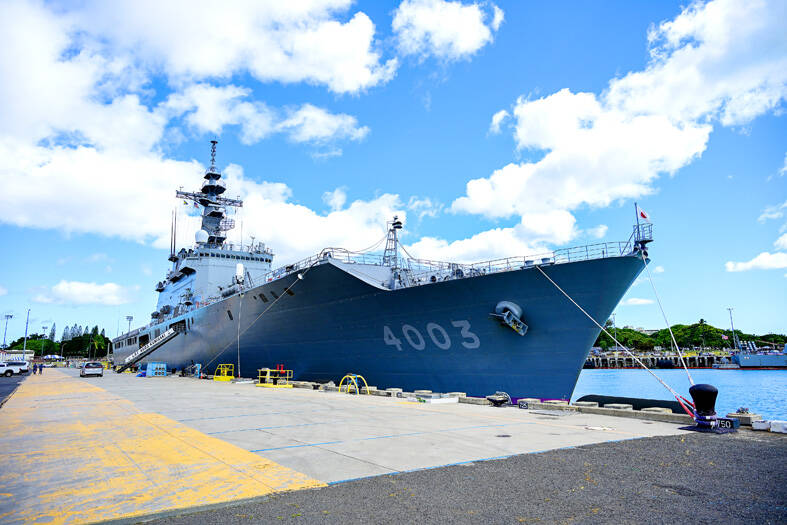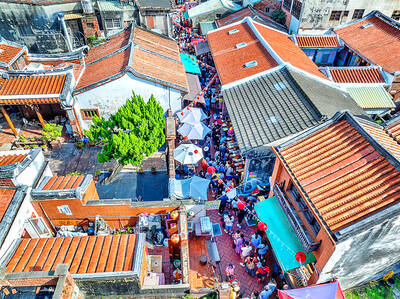A retired Japanese admiral yesterday called on the US, Japan and Taiwan to form a direct trilateral communication channel to share intelligence to jointly prevent a potential Chinese invasion of Taiwan.
Former Japanese Maritime Self-Defense Force chief of staff Tomohisa Takei told a forum in Taipei that territorial disputes in the West Pacific have intensified over the past decade as China sees territorial ownership as “an issue that can never be conceded.”
Since Chinese President Xi Jinping (習近平) assumed power, China has made it clear that the Diaoyutai Islands (釣魚台), also known as Senkaku Islands in Japanese, and Taiwan are “at the very core of Chinese core interests,” Takei said.

Photo: CNA
“From this point of view, Japan and Taiwan are inseparably linked in many ways. In particular, the two are in the same boat when it comes to national security,” he said.
Taiwan, Japan and China all claim sovereignty over the Diaoyutai Islands in the East China Sea.
However, the Japanese government was less aware of Taiwan’s geopolitical value to it or the connections between the two countries, Takei said.
“First, what would happen if Taiwan were somehow integrated into China? And second, if Japan and the US fail to defend Taiwan, even in a gray zone situation, a completely different world will emerge in East Asia,” he said.
To prevent such a scenario, the retired admiral said Tokyo needed to strengthen its military cooperation with the US and continue to beef up its own defense capabilities amid China’s continuous defense build-up.
In terms of the US-Japan alliance, Tokyo also needs to elevate its security cooperation with Washington, he said.
He said there should be a “direct triangle approach” between Taiwan and Japan, with the US in the middle.
The Taiwan-US-Japan triangle framework should include information sharing and promote closer coordination on various fronts, Takei said.
He also suggested that Japan continue to strengthen its defense capabilities to complement US attempts to extend its arms posture and its deterrence.
At the same forum, Rick Waters, a former US deputy assistant secretary at the US Department of State’s Bureau of East Asian and Pacific Affairs, said Beijing, including the China Coast Guard, has been very active in deploying “gray zone” tactics in the Indo-Pacific region over the past decade.
The world has witnessed “this emergence of a stronger China, with composite national power now being applied through a multidimensional gray-zone strategy and an arc that spans from India through the South China Sea and the Taiwan Strait, into the East China Sea,” said Waters, now the managing director of Eurasia Group’s China practice.
Beijing’s growing threat has led countries in the region to stand closer, leading to the reshaping of the US-Japan defense alliance to include South Korea and the Philippines, he said.
“So we are starting to see them rely more on each other,” he said.
The issue of Taiwan Strait security also affects others around the globe, which is why the G7, NATO and the EU have over the past few years begun to talk more about the importance of peace and stability and upholding these norms in the Indo-Pacific region, he said.
The two speakers made their remarks during the morning session of the Ketagalan Forum, a government-founded annual international seminar with a focus on security issues in the Indo-Pacific region.

A cat named Mikan (蜜柑) has brought in revenue of more than NT$10 million (US$305,390) for the Kaohsiung MRT last year. Mikan, born on April 4, 2020, was a stray cat before being adopted by personnel of Kaohsiung MRT’s Ciaotou Sugar Refinery Station. Mikan was named after a Japanese term for mandarin orange due to his color and because he looks like an orange when curled up. He was named “station master” of Ciaotou Sugar Refinery Station in September 2020, and has since become famous. With Kaohsiung MRT’s branding, along with the release of a set of cultural and creative products, station master Mikan

RISING TOURISM: A survey showed that tourist visits increased by 35 percent last year, while newly created attractions contributed almost half of the growth Changhua County’s Lukang Old Street (鹿港老街) and its surrounding historical area clinched first place among Taiwan’s most successful tourist attractions last year, while no location in eastern Taiwan achieved a spot in the top 20 list, the Tourism Administration said. The listing was created by the Tourism Administration’s Forward-looking Tourism Policy Research office. Last year, the Lukang Old Street and its surrounding area had 17.3 million visitors, more than the 16 million visitors for the Wenhua Road Night Market (文化路夜市) in Chiayi City and 14.5 million visitors at Tainan’s Anping (安平) historical area, it said. The Taipei 101 skyscraper and its environs —

Taiwan on Friday said a New Zealand hamburger restaurant has apologized for a racist remark to a Taiwanese customer after reports that it had first apologized to China sparked outrage in Taiwan. An image posted on Threads by a Taiwanese who ate at Fergburger in Queenstown showed that their receipt dated Sunday last week included the words “Ching Chang,” a racial slur. The Chinese Consulate-General in Christchurch in a statement on Thursday said it had received and accepted an apology from the restaurant over the incident. The comment triggered an online furor among Taiwanese who saw it as an insult to the

ENROLLMENT STRATEGIES: NTNU focuses on English instruction to attract foreign students, and helps them with employment and internships, its president said The number of foreign students in the nation’s colleges and universities hit a five-year high last year, with National Taiwan Normal University (NTNU) topping the list with the most international students, Ministry of Education data showed. Last year, 123,188 international students attended Taiwanese colleges and universities, 3,259 more than the previous academic year, the data showed. NTNU had the most international students, with 7,648 students, followed by the National Taiwan University’s 6,249, it showed. NTNU yesterday said that international students accounted for 12.05 percent of its degree students last year. The percentage of overseas Chinese students at the university has also been the highest